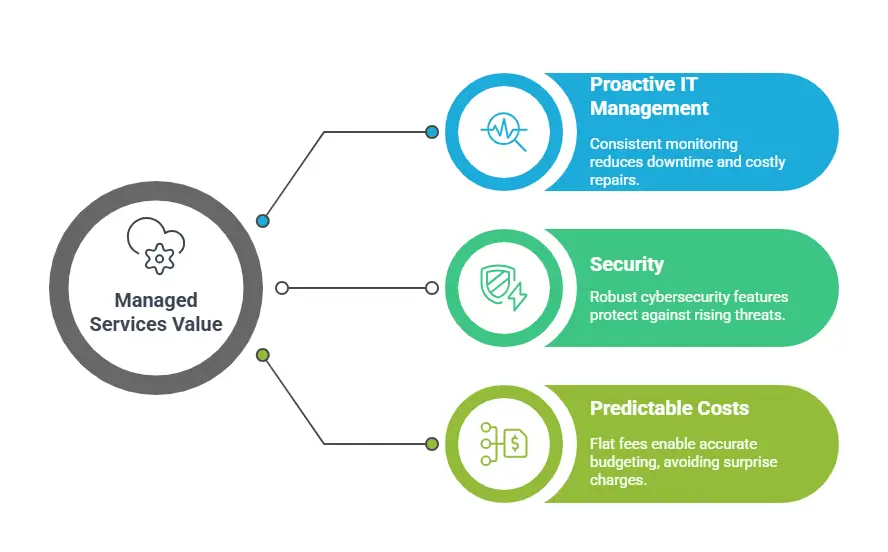
Break-Fix vs Managed Services: How They Could Shape Your IT Strategy
Choosing the right IT service model for your business is crucial. The decision between break-fix and managed services can directly impact your productivity, security, and bottom line. As businesses evolve, their IT needs become more complex. A reactive approach may no longer work.
According to a report by CompTIA, 13% of businesses cut their IT costs by over 50% after switching to managed services.
Kevin White, CEO of TRINUS, puts it this way: “Investing in a proactive IT strategy ensures business continuity and boosts overall productivity.”
So, which model is right for your business? Let’s break down the differences between break-fix and managed services and explore how these models can impact your operations.
Empower Your Business with TRINUS Proactive IT SupportMaximize uptime, strengthen security, and reduce risk with managed IT services. |
What Break Fix Services Entail
Break-fix services refer to an IT model where businesses only pay when something breaks. It’s a pay-as-you-go system. When your equipment fails or something goes wrong with your network, you call an IT provider to fix the issue.
You get charged for parts, labor, and the time spent on repairs. This model was once popular because it seemed cheaper. After all, why pay for something that’s working?
In reality, however, this system can lead to unforeseen costs. A single issue can escalate quickly. What starts as a small problem might become bigger and more expensive if left unchecked.
Common services under the break-fix model include:
- Hardware repairs or replacements: You call when something breaks or needs to be upgraded.
- Network fixes: You don’t know it’s broken until something stops working.
- Software issues: Your antivirus or operating system might fail, and you call for help.
- One-off staff training: When new software or hardware is introduced, employees need quick training.
While these services seem straightforward, they lack foresight. In the end, break-fix services are reactive, not proactive.
What Managed Services Really Mean
In contrast, managed services is a model that offers ongoing support and maintenance. Here, your IT provider takes on a more strategic role. Rather than waiting for something to break, they proactively manage and monitor your network, systems, and data.
This model focuses on prevention. By continuously tracking system performance, the provider resolves issues before they become significant problems.
In a managed services agreement, the IT provider typically handles:
- Remote monitoring: They keep an eye on your system 24/7.
- Regular maintenance and updates: Ensuring your network and devices are up to date and running smoothly.
- Cybersecurity measures: Preventing threats before they reach your system.
- Helpdesk and support: Providing round-the-clock assistance for any IT-related issues.
For most businesses, managed services provide a stable, long-term IT solution. You know exactly how much you’ll be paying each month. Your provider ensures uptime, security, and efficiency through ongoing service.
Key Differences in Cost Structure
When it comes to break-fix vs managed services, one of the most significant differences is the cost structure.
- Break Fix Services: You pay only when something goes wrong. However, small repairs can add up quickly. A single incident might cost less than the monthly fee of a managed service, but it could lead to more expensive issues down the line.
- Managed Services: With managed services, you pay a flat monthly rate. This often includes all your IT needs, from monitoring and updates to cybersecurity. The benefit here is predictability. There are no surprise charges for unexpected repairs. Research also shows that managed IT services potentially reduce costs by 25-40%.
While break-fix services seem cheaper at first glance, managed services save you money in the long term. When you factor in potential downtime and costly emergency repairs, managed services typically offer more value for money.
How Service Delivery and Proactive Support Differ
One of the most crucial aspects of break-fix vs managed services is the difference in service delivery.
- Break Fix Services: As the name suggests, the break fix services model only reacts to problems. It’s a hit-or-miss approach, where the issue might be fixed, but there’s no ongoing support to ensure it doesn’t happen again. The risk here is that you’re never entirely sure your systems are healthy until something breaks.
- Managed Services: With managed services, you’re getting proactive support. The provider monitors your systems, detects issues early, and fixes them before they affect your business. This is a much more stable, reliable approach. When your IT provider works behind the scenes to keep your systems running, you’ll have fewer unexpected disruptions.
| More articles you might like: |
Why Break Fix Services Might Appeal to Some Businesses
While break-fix services might seem outdated to many businesses, they can still work well for specific organizations.
- Lower upfront costs: If your business doesn’t need lots of IT support, break fix services could be a good choice.
- No long-term commitment: Some businesses prefer the flexibility of paying only when they need service.
- Small businesses with low IT needs: If you’re a small business with limited IT infrastructure, you might not need the full range of services offered by managed services providers.
That said, while break-fix services can seem appealing due to lower costs upfront, it’s essential to understand the long-term implications. Downtime, data loss, and unplanned outages can quickly outweigh the initial savings.
Why Managed Services Offer More Long-Term Value
For most businesses, managed services provide more long-term value than break-fix services. Here’s why:
- Proactive IT management: With managed services, you’re not just reacting to issues as they occur. Instead, experts consistently monitor, update and secure your IT systems. This reduces the risk of downtime and costly repairs.
- Security: Nearly 47% of small businesses faced at least one cyberattack last year, with 44% experiencing multiple attacks. Cyber attacks are on the rise. Managed services providers take cybersecurity seriously. They offer features like firewalls, encryption, and intrusion detection to protect your systems.
- Predictable Costs: With a flat monthly fee, you can budget IT expenses accurately. You won’t face surprise charges for emergency repairs.
When it comes to keeping your business running smoothly, managed services offer peace of mind. With 24/7 monitoring, you can rest assured that potential issues will be caught before they become major problems.
When Does Break Fix Still Make Sense?
Despite the rise of managed services, there are still scenarios where break-fix services might make sense.
- Small businesses with minimal IT infrastructure: If you don’t rely heavily on IT systems, you may not need the full range of services managed providers offer.
- Businesses with an in-house IT team: If you have dedicated IT staff, you might only need external help for specific issues.
- Companies on a tight budget: While managed services often save money in the long run, some businesses prefer to pay as needed until their IT needs grow.However, even in these cases, businesses should carefully assess their needs and consider the potential risks of waiting for problems to arise.
How to Transition from Break Fix to Managed Services
Making the switch from break-fix services to managed services can be a significant change for any business.
Here are some tips for a smooth transition:
- Assess your needs: Start by evaluating your current IT environment. What’s working well, and what could be improved?
- Choose the right provider: Look for a provider that understands your business needs and offers flexible, tailored solutions.
- Set clear expectations: Discuss service level agreements (SLAs) and ensure you’re on the same page regarding response times and support levels.
Transitioning to managed services is an investment in the future of your business. The right provider can help guide you through the change, ensuring minimal disruption.
Factors to Consider When Choosing Between Break Fix and Managed Services
When deciding between break-fix and managed services, you must consider several factors. The table below highlights key elements that can influence your decision.
| Factor | Importance |
| Response Time | Ensure rapid IT support to prevent downtime. |
| Security Measures | Verify if the provider offers advanced threat protection. |
| Industry Expertise | Choose a provider experienced in your industry’s specific needs. |
| Scalability | Opt for services that grow with your business. |
| Cost Transparency | Confirm pricing structures to avoid hidden fees. |
Optimize Your IT with TRINUS Managed IT Services
Investing in the right types of managed services keeps your business secure, efficient, and future-ready. These solutions reduce downtime, enhance cybersecurity, and improve overall performance.
TRINUS has delivered expert IT management for over 25 years, with zero ransomware incidents across all managed clients.
| Reliable Managed IT Services Near You |
| Edmonton |
Our tailored services help businesses navigate complex IT challenges with confidence. Contact us today to discuss your IT needs and schedule a free cybersecurity assessment.




















